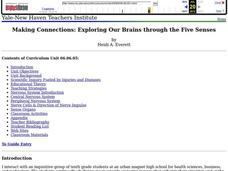K12 Reader
Anne of Avonlea
Middle schoolers read a passage from Lucy Maud Montgomery's Anne of Avonlea and identify three details from the passage that show Anne is nervous as she faces her students for the first time.
Global Oneness Project
Flamenco: A Cross-Cultural Art Form
Notes of pride and persecution, exclusion and isolation resonate in flamenco. Introduce this musical art form to your social studies or Spanish language classes with a resource that follows a young flamenco guitarist as he...
Curated OER
Lotto or Life: What Are the Chances?
Though the website does not seem to have the mentioned video, a reding and lottery style games simulate the chances of finding intelligent life somewhere other than Earth. Without the video, this lesson is short, but it can be a useful...
Curated OER
Whale Is Stuck
Students engage in the process of problem solving with the help of children's literature story of how the whale was trapped and then freed. The story illustrates the power of teamwork and commitment. The students practice the skill of...
Curated OER
Biopoem
Reinforce the actions, emotions, and characteristics that determine what a character is like by having your middle schoolers create a biopoem using the model presented here. You could engage them first by having them write a poem about...
Curated OER
Stereotype Characters Activity
Here is a lesson designed for middle schoolers which helps them recognize stereotypes one way or another against a particular group of people. They also determine what may have motivated the author to use a stereotype in the first place....
Bright Hub Education
Don Quixote
The ideas present for analyzing Don Q are tried and true, and the beginner to the novel will find the information helpful. The most productive activity on this resource would be the mind map (link available) that gives readers and...
Curated OER
Hoot: Vocabulary: Magic Squares
Define words with numbers in a fun vocabulary activity. Using words from Hoot by Carl Hiaasen, learners use a grid to match words and their definitions, and to find the magic number that is the same when the numbers are added from...
Curated OER
Three Little Pigs and Heat Transfer
Students use the Internet to research the ancient practices of building structures and to help them recognize what building materials serve as good conductors and insulators of heat. They build a structure using straw bale walls.
Curated OER
A Poetic Finale
Young scholars write a poetic response to the Holocaust as a culminating activity to a unit on the Holocaust. They listen to and discuss a rap song about the Holocaust, complete various handouts, and write a poem for future generations.
Curated OER
The Daytime D-Day Hour: Producing a D-Day Talkshow
Young scholars analyze the key players and events of D-Day during World War II. They conduct research on an assigned character's role in D-Day, complete worksheets, and plan and participate in a D-Day talk show, presenting information in...
Curated OER
Making Connections: Exploring Our Brains through the Five Senses
Students record observations and create drawings and models of anatomy using their five senses. They describe the structures of a neuron and analyze each of their functions. They compare and contrast the typical structural features of a...
Curated OER
Scientific Method
Students examine the steps of the scientific method. They define related vocabulary terms, view a PowerPoint presentation, and apply and identify the steps of the scientific method for an online experiment scenario.
Curated OER
An Exploration of the Slope of a Line
Learners define the slope of a line. In this algebra lesson plan, students differentiate between parallel and perpendicular lines using their slopes. They rewrite equations in slope intercept form and explain the meaning of the slope.
Curated OER
Monitoring an Epidemic: Analyzing Through Graphical Displays Factors Relating to the Spread of HIV/AIDS
Tenth graders differentiate pandemic and epidemic. In this health science lesson, 10th graders analyze how HIV and AIDS affect different countries. They construct and interpret different types of graphs.
Curated OER
Making Connections: Exploring Our Brains through the Five Senses
Students identify structures of the brain, and neurons and analyze their functions. In this nervous system lesson students create drawings and models of anatomy.
Curated OER
Preschoolers and Science Skills
You can encourage critical thinking and problem solving by allowing young children to participate in hands-on science activities.
Curated OER
World History Fall Final: Ancient History to the American Revolution
A variety of topics and activities make up this presentation, which prompts viewers to answer questions from the Stone Age to the American Revolution. Note: You may find some slides more useful and pertinent than others.
Curated OER
The Counter Reformation
In this Counter Reformation study guide learning exercise, students read a brief overview pertaining to the time period in world history and then respond to 3 reflection questions.
Curated OER
Structure of Earth
Seventh graders study and make a model of the significant formations of the ocean floor. They examine images and illustration and apply their imagination while creating the model. They are challenged to complete further research as an...
Curated OER
Heredity: Your Connection To The Past
Students investigate genetics and the process of reproduction in living organisms.
Curated OER
Earth's Ecosystem: Seven Major Biomes
Students discuss the different types of ecosystems and the composition of biomes. Working in groups, they define various related terms and make posters of them. Then they explain their posters to the class.
Curated OER
LIONS and TIGERS and BEARS. . .Oh My! Animals of Connecticut and the World
Students identify and list the different types of pets owned by the children in the class.
They graph the total number of each type of pet owned. They draw or cut-out a picture of an animal. Using the materials listed above, the children...























